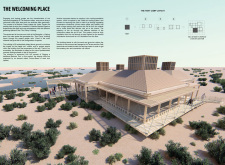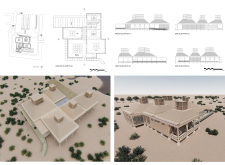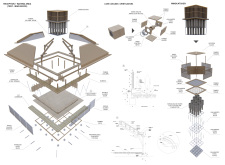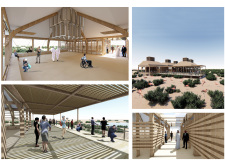5 key facts about this project
The Visitor Center at Al Wathba Wetland Reserve showcases a thoughtful design that highlights the cultural significance of the Bedouin tribes, while also addressing the delicate environmental context of the area. Located within a vibrant wetland ecosystem, the center acts as an entry point for visitors, offering educational programs about the region's natural beauty and biodiversity. The overall design promotes hospitality and community interaction, establishing spaces that invite relaxation and exploration.
Cultural Influence and Concept
Central to the design is the idea of a Bedouin Camp, which informs both the layout and spatial arrangements. A prominent feature of the center is the square tent that serves as the Reception and Waiting area. This structure employs the golden ratio, lending a sense of balance to the environment. The use of wood creates a connection to nature, allowing the Visitor Center to blend with its setting while offering warmth and an inviting atmosphere.
Structural Design and Elevation
The building is positioned above the ground, a choice made to reduce its impact on the surrounding soil and wildlife. This elevation is achieved through prefabricated concrete footings, which help minimize excavation and protect the sensitive environment. The design also pays homage to local architectural traditions with sloping roofs supported by Column-Beams, providing both structural integrity and an element of cultural identity.
Ventilation and Sustainability Features
An efficient cooling and ventilation system demonstrates the design's responsiveness to the local climate. Inspired by a "Bottle air cooling system," this method captures and channels wind to regulate indoor temperatures. Wired mache paper clay bottles are used for the conductors, allowing warm air to enter through larger openings while smaller exits provide cooled air. This practical approach not only enhances comfort for visitors but also aligns with sustainable practices.
Connection to Nature
The Visitor Center encourages interaction with the natural environment, featuring exterior spaces where visitors can relax and enjoy the scenery. A Terrace and Cafe area overlook a flamingo habitat, fostering a direct connection to local wildlife. This arrangement enriches the visitor experience by providing opportunities to observe and appreciate the wetlands' ecological importance. The design ensures that the boundaries between built space and natural surroundings are fluid, inviting individuals to reflect on their relationship with the landscape.






















































